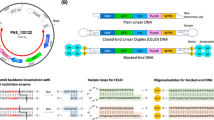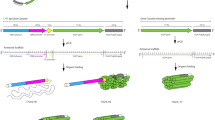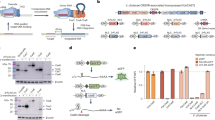Abstract
The ability to safely and efficiently transfer foreign DNA into cells is a fundamental goal in biotechnology. Toward this end, rapid advances have recently been made in our understanding of mechanisms for DNA stability and transport within cells. Current synthetic DNA delivery systems are versatile and safe, but substantially less efficient than viruses. Indeed, most current systems address only one of the obstacles to DNA delivery by enhancing DNA uptake. In fact, the effectiveness of gene expression is also dependent on several additional factors, including the release of intracellular DNA, stability of DNA in the cytoplasm, unpackaging of the DNA–vector complex, and the targeting of DNA to the nucleus. Delivery systems of the future must fully accommodate all these processes to effectively shepherd DNA across the plasma membrane, through the hostile intracellular environment, and into the nucleus.
This is a preview of subscription content, access via your institution
Access options
Subscribe to this journal
Receive 12 print issues and online access
$209.00 per year
only $17.42 per issue
Buy this article
- Purchase on Springer Link
- Instant access to full article PDF
Prices may be subject to local taxes which are calculated during checkout


Similar content being viewed by others
References
Rolland, A.P. From genes to gene medicines: recent advances in nonviral gene delivery. Crit. Rev. Ther. Drug Carrier Syst. 15, 143– 198 (1998).
Fasbender, A., Zabner, J., Zeiher, B.G. & Welsh, M.J. A low rate of cell proliferation and reduced DNA uptake limit cationic lipid-mediated gene transfer to primary cultures of ciliated human airway epithelia. Gene Ther. 4, 1173–1180 (1997).
Matsui, H., Johnson, L.G., Randell, S.H. & Boucher, R.C. Loss of binding and entry of liposome–DNA complexes decreases transfection efficiency in differentiated airway epithelial cells. J. Biol. Chem. 272, 1117–1126 ( 1997).
Anderson, W.F. Human gene therapy. Nature 392, 25– 30 (1998).
Crystal, R.G. Transfer of genes to humans: early lessons and obstacles to success. Science 270, 404–410 ( 1995).
Tripathy, S.K., Black, H.B., Goldwasser, E. & Leiden, J.M. Immune responses to transgene-encoded proteins limit the stability of gene expression after injection of replication-defective adenovirus vectors. Nat. Med. 2, 545–550 ( 1996).
Mann, M.J. et al. Pressure-mediated oligonucleotide transfection of rat and human cardiovascular tissues. Proc. Natl. Acad. Sci. USA 96, 6411–6416 (1999).
Liu, F., Song, Y. & Liu, D. Hydrodynamics-based transfection in animals by systemic administration of plasmid DNA. Gene Ther. 6, 1258– 1266 (1999).
Zhang, G., Budker, V. & Wolff, J.A. High levels of foreign gene expression in hepatocytes after tail vein injections of naked plasmid DNA. Hum. Gene Ther. 10, 1735–1737 ( 1999).
Pillai, R et al. Ultrasonic nebulization of catonic lipid-based gene delivery systems for airway administration. Pharm. Res. 15, 1743– 1747.
Yang, N.S., Burkholder, J., Roberts, B., Martinell, B. & McCabe, D. In vivo and in vitro gene transfer to mammalian somatic cells by particle bombardment. Proc. Natl. Acad. Sci. USA 87, 9568–9572 (1990).
Yang, N.S. & Sun, W.H. Gene gun and other non-viral approaches for cancer gene therapy. Nat. Med. 1, 481 –483 (1995).
Ye, G.N., Daniell, H. & Sanford, J.C. Optimization of delivery of foreign DNA into higher-plant chloroplasts. Plant Mol. Biol. 15, 809– 819 (1990).
Qiu, P., Ziegelhoffer, P., Sun, J. & Yang, N.S. Gene gun delivery of mRNA in situ results in efficient transgene expression and genetic immunization. Gene Ther. 3, 262–268 (1996).
Fynan, E.F. et al. DNA vaccines: protective immunizations by parenteral, mucosal, and gene-gun inoculations. Proc. Natl. Acad. Sci. USA 90 , 11478–11482 (1993).
Wong, T.K. & Neumann, E. Electric field mediated gene transfer . Biochem. Biophys. Res. Commun. 107, 584 –587 (1982).
Neumann, E., Schaefer-Ridder, M., Wang, Y. & Hofschneider, P.H. Gene transfer into mouse lyoma cells by electroporation in high electric fields . EMBO J. 1, 841–845 (1982).
Banga, A.K. & Prausnitz, M.R. Assessing the potential of skin electroporation for the delivery of protein- and gene-based drugs. Trends Biotechnol. 16, 408–412 (1998).
Oshima, Y. et al. Targeted gene transfer to corneal endothelium in vivo by electric pulse. Gene Ther. 5, 1347–1354 (1998).
Aihara, H. & Miyazaki, J. Gene transfer into muscle by electroporation in vivo. Nat. Biotechnol. 16, 867– 870 (1998).
Rizzuto, G. et al. Efficient and regulated erythropoietin production by naked DNA injection and muscle electroporation. Proc. Natl. Acad. Sci. USA 96, 6417–6422 (1999).
Vaheri, A. & Pagano, J.S. Infectious poliovirus RNA: a sensitive method of assay. Virology 27, 434– 436 (1965).
Felgner, P.L. Particulate systems and polymers for in vitro and in vivo delivery of polynucleotides . Adv. Drug Deliv. Rev. 5, 163– 187 (1990).
Graham, F.L. & Eb, A.J.V.D. A new technique for the assay of infectivity of human adenovirus 5 DNA. Virology 52, 456–467 (1973).
Felgner, P.L. et al. Lipofection: a highly efficient, lipid-mediated DNA-transfection procedure. Proc. Natl. Acad. Sci. USA 84, 7413–7417 (1987).
Lee, R.J. & Huang, L. Lipidic vector systems for gene transfer . Crit. Rev. Ther. Drug Carrier Syst. 14, 173–206 (1997).
Templeton, N.S. & Lasic, D.D. New directions in liposome gene delivery. Mol Biotechnol 11, 175–180 (1999).
Monkkonen, J. & Urtti, A. Lipid fusion in oligonucleotide and gene delivery with cationic lipids. Adv. Drug Del. Rev. 34, 37–49 (1998).
Maurer, N. et al. Lipid-based systems for the intracellular delivery of genetic drugs. Mol. Membr. Biol. 16, 129–140 (1999).
Schuber, F., Kichler, A., Boeckler, C. & Frisch, B. Liposomes: from membrane models to gene therapy. Pure Appl. Chem. 70, 89–96 ( 1998).
Smith, J., Zhang, Y.L. & Niven, R. Toward development of a non-viral gene therapeutic. Adv. Drug Del. Rev. 26, 135–150 (1997).
Filion, M.C. & Phillips, N.C. Major limitations in the use of cationic liposomes for DNA delivery. Int. J. Pharmaceut. 162, 159–170 (1998).
Wolff, J.A. et al. Direct gene transfer into mouse muscle in vivo. Science 247, 1465–1468 ( 1990).
Zabner, J. et al. Comparison of DNA–lipid complexes and DNA alone for gene transfer to cystic fibrosis airway epithelia in vivo. J. Clin. Invest. 100, 1529–1537 (1997).
Zauner, W., Ogris, M. & Wagner, E. Polylysine-based transfection systems utilizing receptor- mediated delivery. Adv. Drug Del. Rev. 30, 97–113 (1998).
Kim, J.S., Kim, B.I., Maruyama, A., Akaike, T. & Kim, S.W. A new non-viral DNA delivery vector: the terplex system . J. Contr. Release 53, 175– 182 (1998).
Wu, C.H., Wilson, J.M. & Wu, G.Y. Targeting genes: delivery and persistent expression of a foreign gene driven by mammalian regulatory elements in vivo. J. Biol. Chem. 264, 16985–16987 (1989).
Schaffer, D.V. & Lauffenburger, D.A. Optimization of cell surface binding enhances efficiency and specificity of molecular conjugate gene delivery. J. Biol. Chem. 273, 28004 –28009 (1998).
Sorgi, F.L., Bhattacharya, S. & Huang, L. Protamine sulfate enhances lipid-mediated gene transfer . Gene Ther. 4, 961–968 (1997).
Schwartz, B. et al. Synthetic DNA-compacting peptides derived from human sequence enhance cationic lipid-mediated gene transfer in vitro and in vivo. Gene Ther. 6, 282–292 ( 1999).
Paul, R.W. et al. Gene transfer using a novel fusion protein, GAL 4/invasin. Hum Gene Ther. 8, 1253–1262 (1997).
Smith, L.C. et al. Synthetic peptide-based DNA complexes for nonviral gene delivery . Adv. Drug Del. Rev. 30, 115– 131 (1998).
Karak, N. & Maiti, S. Dendritic polymers: a class of novel material. J. Polymer Mater. 14, 105 ( 1997).
Haensler, J. & Szoka, F.C., Jr. Polyamidoamine cascade polymers mediate efficient transfection of cells in culture. Bioconjug. Chem. 4, 372–379 (1993).
Kukowska-Latallo, J.F. et al. Efficient transfer of genetic material into mammalian cells using Starburst polyamidoamine dendrimers. Proc. Natl. Acad. Sci. USA 93, 4897–4902 ( 1996).
Tang, M.X., Redemann, C.T. & Szoka, F.C. Jr. In vitro gene delivery by degraded polyamidoamine dendrimers. Bioconjug. Chem. 7, 703–714 (1996).
Choi, J.S., Lee, E.J., Choi, Y.H., Jeong, Y.J. & Park, J.S. Poly(ethylene glycol)-block-poly(l-lysine) dendrimer: novel linear polymer/dendrimer block copolymer forming a spherical water-soluble polyionic complex with DNA. Bioconjug. Chem. 10, 62–65 (1999).
Godbey, W., Wu, K., Hirasaki, G. & Mikos, A. Improved packing of poly(ethylenimine)/DNA complexes increases transfection efficiency. Gene Ther. 6, 1380–1388 (1999).
Diebold, S.S., Kursa, M., Wagner, E., Cotten, M. & Zenke, M. Mannose polyethylenimine conjugates for targeted DNA delivery into dendritic cells. J. Biol. Chem. 274, 19087–19094 (1999).
Ogris, M. et al. The size of DNA/transferrin–PEI complexes is an important factor for gene expression in cultured cells. Gene Ther. 5, 1425–1433 (1998).
Chemin, I. et al. Liver-directed gene transfer: a linear polyethlenimine derivative mediates highly efficient DNA delivery to primary hepatocytes in vitro and in vivo . J. Viral Hepat. 5, 369– 375 (1998).
Truong-Le, V.L., August, J.T. & Leong, K.W. Controlled gene delivery by DNA-gelatin nanospheres . Hum. Gene Ther. 9, 1709– 1717 (1998).
Leong, K.W. et al. DNA–polycation nanospheres as nonviral gene delivery vehicles . J. Contr. Release 53, 183– 193 (1998).
van de Wetering, P., Moret, E.E., Schuurmans-Nieuwenbroek, N.M., van Steenbergen, M.J. & Hennink, W.E. Structure–activity relationships of water-soluble cationic methacrylate/methacrylamide polymers for nonviral gene delivery. Bioconjug. Chem. 10, 589–597 (1999).
Van de Woude, I. et al. Novel pyridinium surfactants for efficient, nontoxic in vitro gene delivery. Proc. Natl. Acad. Sci. USA 94, 1160–1165 (1997).
Jones, D.H., Corris, S., McDonald, S., Clegg, J.C. & Farrar, G.H. Poly(dl-lactide-co-glycolide)-encapsulated plasmid DNA elicits systemic and mucosal antibody responses to encoded protein after oral administration. Vaccine 15, 814 –817 (1997).
Ando, S., Putnam, D., Pack, D.W. & Langer, R. PLGA microspheres containing plasmid DNA: preservation of supercoiled DNA via cryopreparation and carbohydrate stabilization. J. Pharm. Sci. 88, 126–130 (1999).
Wang, D., Robinson, D.R., Kwon, G.S. & Samuel, J. Encapsulation of plasmid DNA in biodegradable poly(d,l-lactic- co-glycolic acid) microspheres as a novel approach for immunogene delivery . J. Contr. Release 57, 9– 18 (1999).
Luo, D., Woodrow-Mumford, K., Belcheva, N. & Saltzman, W.M. Controlled DNA delivery systems. Pharm. Res. 16, 1300–1308 (1999).
Shea, L.D., Smiley, E., Bonadio, J. & Mooney, D.J. DNA delivery from polymer matrices for tissue engineering. Nat. Biotechnol. 17, 551–554 ( 1999).
Pouton, C.W. & Seymour, L.W. Key issues in non-viral gene delivery . Adv. Drug Del. Rev. 34, 3– 19 (1998).
El Ouahabi, A. et al. The role of endosome destabilizing activity in the gene transfer process mediated by cationic lipids. FEBS Lett. 414 , 187–192 (1997).
Wagner, E. et al. Coupling of adenovirus to transferrin-polylysine/DNA complexes greatly enhances receptor-mediated gene delivery and expression of transfected genes. Proc. Natl. Acad. Sci. USA 89, 6099– 6103 (1992).
Boussif, O. et al. A versatile vector for gene and oligonucleotide transfer into cells in culture and in vivo: polyethylenimine. Proc. Natl. Acad. Sci. USA 92, 7297–7301 ( 1995).
Duguid, J.G. et al. A physicochemical approach for predicting the effectiveness of peptide-based gene delivery systems for use in plasmid-based gene therapy. Biophys. J. 74, 2802–2814 ( 1998).
Uherek, C., Fominaya, J. & Wels, W. A modular DNA carrier protein based on the structure of diphtheria toxin mediates target cell-specific gene delivery. J. Biol. Chem. 273, 8835–8841 (1998).
Greber, U.F., Willetts, M., Webster, P. & Helenius, A. Stepwise dismantling of adenovirus 2 during entry into cells. Cell 75, 477–486 ( 1993).
Wagner, E., Plank, C., Zatloukal, K., Cotten, M. & Birnstiel, M.L. Influenza virus hemagglutinin HA-2 N-terminal fusogenic peptides augment gene transfer by transferrin-polylysine-DNA complexes: toward a synthetic virus-like gene-transfer vehicle. Proc. Natl. Acad. Sci. USA 89, 7934–7938 ( 1992).
Plank, C., Oberhauser, B., Mechtler, K., Koch, C. & Wagner, E. The influence of endosome-disruptive peptides on gene transfer using synthetic virus-like gene transfer systems . J. Biol. Chem. 269, 12918– 12924 (1994).
Katayose, S. & Kataoka, K. Water-soluble polyion complex associates of DNA and poly(ethylene glycol)-poly(l-lysine) block copolymer. Bioconjug. Chem. 8, 702–707 (1997).
Xu, B., Wiehle, S., Roth, J.A. & Cristiano, R.J. The contribution of poly-l-lysine, epidermal growth factor and streptavidin to EGF/PLL/DNA polyplex formation. Gene Ther. 5, 1235– 1243 (1998).
Ross, G.F. et al. Enhanced reporter gene expression in cells transfected in the presence of DMI-2, an acid nuclease inhibitor. Gene Ther. 5, 1244–1250 (1998).
Schaffer, D.V., Fidelman, N.A., Dan, N. & Lauffenburger, D.A. Vector unpackaging as a potential barrier for receptor-mediated polyplex gene delivery . Biotechnol. Bioeng., in press (1999).
Pollard, H. et al. Polyethylenimine but not cationic lipids promotes transgene delivery to the nucleus in mammalian cells. J. Biol. Chem. 273 , 7507–7511 (1998).
Godbey, W.T., Wu, K.K. & Mikos, A.G. Tracking the intracellular path of poly(ethylenimine)/DNA complexes for gene delivery. Proc. Natl. Acad. Sci. USA 96, 5177–5181 (1999).
Holmes, A.R., Dohrman, A.F., Ellison, A.R., Goncz, K.K., & Gruenert, D.C. Intracellular compartmentalization of DNA fragments in cultured airway epithelial cells mediated by cationic lipids. Pharm. Res. 16, 1020– 1025 (1999).
Branden, L.J., Mohamed, A.J. & Smith, C.I. A peptide nucleic acid-nuclear localization signal fusion that mediates nuclear transport of DNA. Nat. Biotechnol. 17, 784–787 ( 1999).
Ziemienowicz, A., Gorlich, D., Lanka, E., Hohn, B. & Rossi, L. Import of DNA into mammalian nuclei by proteins originating from a plant pathogenic bacterium. Proc. Natl. Acad. Sci. USA 96, 3729–3733 (1999).
Subramanian, A., Ranganathan, P. & Diamond, S.L. Nuclear targeting peptide scaffolds for lipofection of nondividing mammalian cells. Nat. Biotechnol. 17 , 873–877 (1999).
Mahato, R.I., Takakura, Y. & Hashida, M. Nonviral vectors for in vivo gene delivery: physicochemical and pharmacokinetic considerations. Crit. Rev. Ther. Drug Carrier Syst. 14, 133–172 ( 1997).
Acknowledgements
Our work on DNA delivery systems is supported by the National Institutes of Health. We thank Phil L. Felgner for his helpful comments on historical activity in the development of synthetic DNA delivery systems and for his suggestion of several references that added substantially to the manuscript. We thank Douglas A. Lauffenburger for helpful discussions and for providing a prepublication copy of reference72.
Author information
Authors and Affiliations
Corresponding author
Rights and permissions
About this article
Cite this article
Luo, D., Saltzman, W. Synthetic DNA delivery systems. Nat Biotechnol 18, 33–37 (2000). https://doi.org/10.1038/71889
Received:
Accepted:
Issue Date:
DOI: https://doi.org/10.1038/71889
This article is cited by
-
Recent Advances in Management of Neuropathic, Nociceptive, and Chronic Pain: A Narrative Review with Focus on Nanomedicine, Gene Therapy, Stem Cell Therapy, and Newer Therapeutic Options
Current Pain and Headache Reports (2024)
-
Dual-dynamic-bond cross-linked injectable hydrogel of multifunction for intervertebral disc degeneration therapy
Journal of Nanobiotechnology (2022)
-
Precise genome editing across kingdoms of life using retron-derived DNA
Nature Chemical Biology (2022)
-
Zoledronic acid-loaded cationic methylcellulose polyplex nanoparticles for enhanced gene delivery efficiency and breast cancer cell killing effect
Applied Nanoscience (2022)
-
Laser Machined Fiber-Based Microprobe: Application in Microscale Electroporation
Advanced Fiber Materials (2022)



